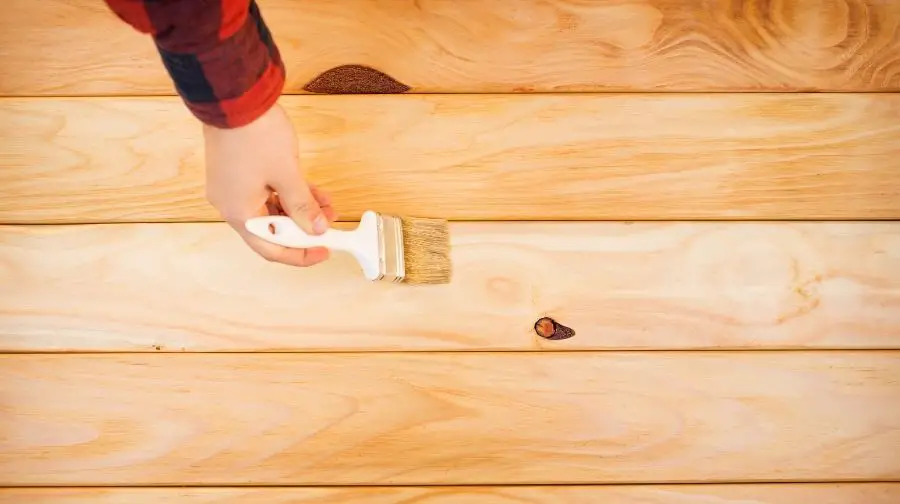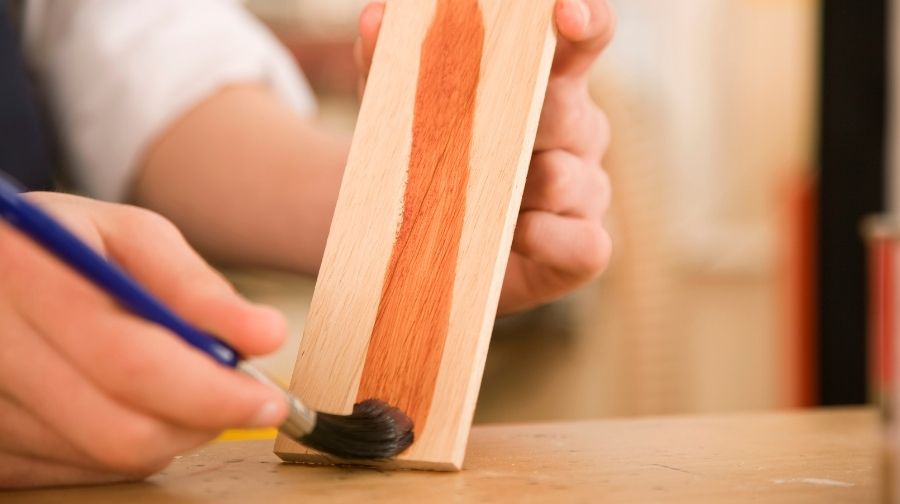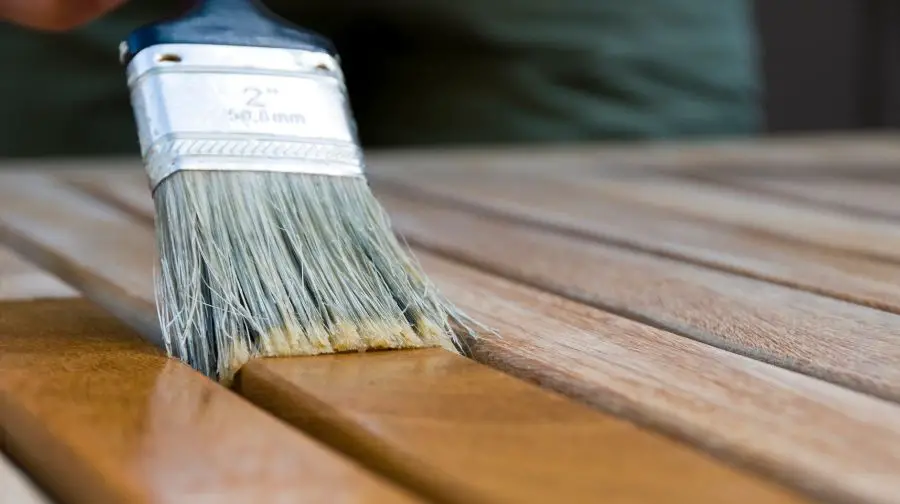
When prepping a deck, porch, or fence for stain, you want to do everything possible to ensure the new coat of paint looks fantastic. The pre-stain wood conditioner is one of those things that can make a huge difference in the final product. This article will teach you how pre-stain wood conditioner works and how it benefits your project.
What is a Pre-Stain Wood Conditioner?
A pre-stain wood conditioner is a liquid solution that is usually painted on the wood before it is stained. It penetrates into the wood fibers and conditions them so that they are more receptive to stains and sealers.
Furthermore, it can help extend the life of a wooden surface by sealing it against moisture, which leads to cracks and warping, prevents fading of light-colored woods, and enhances color.
Why is Pre-Stain Wood Conditioner Important?
A pre-stain wood conditioner is an organic product made of organic elements that have been designed to help with the penetration of the stain onto the surface. A pre-stain wood conditioner is applied to bare or open, unfinished wood to keep it from soaking up all the stain. This will help you to get the best possible coverage with your stain.
Furthermore, a pre-stain wood conditioner protects wooden surfaces from being damaged by staining, making it easier to clean and protect the surface from the stain. It also helps to protect the wood from natural wear and tear as well as provides a better grip for things like paintbrushes so they won’t slip off.
How To Apply Pre-Stain Wood Conditioner?
Pre-Stain Wood Conditioner is a water-based solution that penetrates deeply into the wood pores. It fills (seals) open-cell structure, preventing stain penetration and allowing for even color absorption after staining. Pre-stain conditioners are recommended by most manufacturers of premium stains to achieve maximum colorfastness in your finished product.
Step 1: Use a clean damp cloth to wipe down the wood with water.
Step 2: Apply Pre-Stain Wood Conditioner directly onto your surface, ensuring that it is evenly distributed across the entire application area (use of disposable items is recommended). Let sit for about ten minutes. Note: It may take around two hours, depending on humidity levels and temperature.
Step 3: Wipe off the wood conditioner with a clean, dry cloth to get rid of any excess product. It is essential that you remove all residue from the surface before staining or painting your project. Failure to do so can lead to not ideal results and discoloration of finished products.
Subscribe to B&O Craftsman on Youtube
Should I use Pre-Stain Wood Conditioner?
Subscribe to B&O Craftsman on Youtube
Pre-Stain Wood Conditioner Oil-Based
Unfinished wood can be treated with oil-based Pre-Stain Wood Conditioners to help protect it from water, stains, and scuffs. They’re made for furniture that comes into direct contact with the ground or stains.
The best oil-based Pre-Stain Wood Conditioner should be easy to use and appropriate with your project. It must also be water and mold resistant. If you choose the correct company, you’ll obtain a high-quality product that will protect your furniture for years.
Pre-Stain Wood Conditioner Water-Based
A wood pre-stain wood conditioner is a water-based product that is used to protect the wood and paint from changing after it’s been stained. The products remove unwanted odors and other residues that can’t be removed by just washing, such as smoke and dampness.
It also helps to improve the color of your wood stain and during application. You can use water-based products on new or processed wood, but you cannot use oil-based products on any type of wood.
Best Pre-Stain Wood Conditioner
Minwax Pre-Stain Wood Conditioner is a water-based, low odor formula that allows for easy application in difficult-to-reach areas. This product penetrates deeply into the pores to condition the wood before staining. It is designed for use on unfinished or previously stained wood surfaces prior to applying any surface finishes, which only need to be applied to the top of the wood.
The Minwax Pre-Stain Wood Conditioner has been specially formulated to penetrate deep into pores when used before staining unfinished wood surfaces. When it is used as the first coat of finish, it seals and conditions uneven surfaces and lightly stains them.
This can be used with both oil-based and water-based products, but it is best to test on an inconspicuous area first before using this product as a primer under lacquer or other finishes that are applied over a stain.
Subscribe to 731 Woodworks on Youtube
DIY Pre-Stain Wood Conditioner
Diy Pre-Stain Wood Conditioner is a product that has been in existence for a long time. It is a natural product that will coat the surface of the wood and allow it to better absorb the stain.
The first thing that is done with Diy Pre-Stain Wood Conditioner is to mix water and the conditioner together. After this is done, one coats the surface of the wood with it by using a paintbrush or a roller. There are some people who may prefer to use a cloth in order to apply the conditioner. The purpose of this is that it will allow for an even coat all over the wood, instead of just allowing one area to get too much or none at all.
The next step is to wait until the surface dries before applying the stain. This gives time for any gaps between the wood and the conditioner to close. It is important that one must not use a stain until this has been done because it can be very difficult for certain stains to adhere properly without proper conditioning of the surface area beforehand.
Precautions should always be taken when using Diy Pre-Stain Wood Conditioner in order to protect your family and your home. The first is to always wear gloves when handling the conditioner because it can cause irritation on open sores and may even be harmful if swallowed or breathed in by those who have sensitivities. It should also never come into contact with food, animals, or plants as this could pose a health risk for them as well.
Is Pre-Stain Wood Conditioner Necessary?
Many woodworkers ask if it’s necessary to apply a pre-stain wood conditioner to the wood surface before using a stain. This question is asked because pre-conditioners are typically clear liquids that are applied to the surface of unfinished wood. The goal of these products is not to color or change the color or texture of the wood. Its only purpose is to prepare the surface for staining.
Pre-stain conditions are used when you want the color in your finished product to be consistent with an aged natural patina after applying a water-based sealant.
To answer this question, it’s important to know what type of finish you want on your project and how durable it needs to be. If you want a clear finish, you won’t need a pre-conditioner because the color of your wood is not important. If you are using an oil-based stain or polyurethane, that will seep into the unfinished wood and give it depth.
If that’s what you want to achieve, then there isn’t any reason for applying a pre-conditioner. However, if you are using a water-based stain or want to achieve different colors in your project, then preconditioning is the only way that it will work.
What Can You Use as A Pre-Stain Wood Conditioner?
You can use a pre-stain wood conditioner to seal the pores of the surface before you apply your stain. This will ensure that the stain goes on smoothly without blotching on your wood.
Some common ingredients in pre-stain wood conditioners are linseed oil, tung oil, mineral spirits, and turpentine. Linseed oil is organic and doesn’t contain any solvents. Tung oil is also an organic product that’s derived from tung nuts. Mineral spirits are petroleum distillates that act as solvents for other substances like oils or waxes. Turpentine is distilled from pine trees and contains “naturally occurring” pentane found in petroleum products like paint thinner or gasoline.

What Happens If You Let the Wood Conditioner Dry Before Staining?
If you let the wood conditioner dry before staining, it will spot an orange peel.
Typically, you would apply the pre-stain wood conditioner and then wait 4-8 hours before staining. This is to allow for penetration into tough or heavily dense woods such as oak or mahogany as well as open porous woods such as pine. If you do not follow this guideline, your finished product could exhibit an uneven look once stained with darker colors because of how lightning agents work on the surface of the wood.
Without proper preparation and allowing time for moisture content (polyurethane) to evaporate, dye molecules can become impacted and less available for absorption, which results in a negative outcome, i.e., spotting out orange peeling effect.
How Long Should the Stain Sit Before Wiping Off?
The stain should be allowed to sit for at least five minutes before wiping off. This allows the color to fully penetrate and dry into the wood. I recommend that the stain be applied in a generous amount and then left to sit for around 15 minutes before it is wiped off. If you wipe the stain off too soon, you will get less color penetration and intensity. It’s best to take your time when applying a stain because all of the hard work pays off in the end with a beautiful finish!
Your stain should be allowed to dry before wiping it. After the stain has dried, you can either wipe with a damp cloth or a very soft brush, a lint-free rag, or a cotton cloth saturated in water. This will help to prevent streaking and to get any of the stains on your surface.
Make Stains Look Better! | DIY Blotch Prevention Formula
Subscribe to The Wood Whisperer on Youtube
Is It Better to Stain Wood with A Brush or Rag?
Better to use a brush.
You need to scrub the stain into the wood for it to adhere properly. You’ll be able to do that more effectively with a brush, which is also ideal for getting stains up off the ground where they might drip.
Lucky for you, brushes are available in many shapes and sizes, so you can choose one that best suits your needs! We have one shaped like an artist’s palette, another made of bamboo with angled bristles so you can reach corners easily, and another with extra-long yarn bristles great for wet areas or vertical surfaces.
Can I Use a Water-Based Conditioner with An Oil-Based Stain?
The quick answer is that it’s not a good idea to use a water-based conditioner with oil-based stains. The long answer is that if you want to try it, you should use the same polymer in the water-based and the oil-based, such as PVA or polyurethane, so they can fully react without one coating stripping the other.

Can You Use a Paper Towel to Stain Wood?
Since water is a main component of wood, it can be difficult to determine whether or not the wood has been well-sealed. For instance, water can easily evaporate through the hard surface of the wood. A paper towel can help you determine whether the wood has been sealed by pressing one end to the surface and pulling it back. If you are able to see the light through the towel, then your wood sealer is still drying.
What Does a Wood Conditioner Do Before Staining?
A wood conditioner prepares the surface of the wood by providing a shield against moisture and sealant so that stains can penetrate more easily.
Also, it is used to bring out the natural beauty of the wood. Wood conditioners provide a more even appearance and color of the finish. A clear coat of stain on top will seal in any oil or moisture, helping prevent future problems with surface checking, cracking, and warping of the wood.
How Does a Wood Conditioner Work?
Wood conditioners help create a water-resistant surface on your furniture by filling pores in the wood before staining. It penetrates into the wood to fill any grooves or pores that could cause water resistance problems later down the road.



